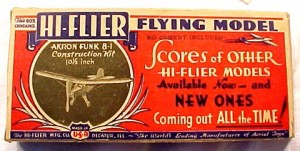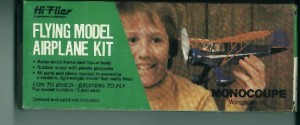Ask me what I know about Decatur, IL, and I’ll tell you that that’s where Hi-Flier kites come from. Came from, at least, in the era when I was an ardent consumer of kites. This was from about 1960 to 1966, roughly when I was in second through eighth grade, on the Northwest Side of Chicago, near Talcott Road and Canfield, right on the border with Park Ridge.
I say “consumer” of kites because that’s how it worked: I saved up a dime, bought a kite down at Bud Maday’s Talcott Hardware Store at Talcott and Canfield, and flew it until I destroyed it, which was anywhere from five minutes to five days after standing up in the Edison School yard and committing my doomed possession to the Windy City’s erratic winds. The poor kites were doomed because we flew them too near the trees that grew in the parkway around the school yard, we flew them in winds too strong for the string we had, and we flew them with second-hand string that other kids had left lying around in the damp grass.
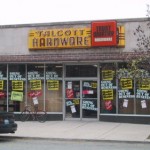 As for Hi-Flier kites, well, we flew them not because of any strong brand loyalty, but because that’s what Bud stocked in his hardware store, and Talcott Hardware was the closest source of kites we had. I knew of TopFlite kites, and Alox kites, but those could only be had at exotic places like Walgreen’s and S. S. Kresge’s that you had to take a car to get to. Bud passed away in 2005, and his children decided to close the store in the summer of that year, after 55 years in business. I was honored to receive the last kite to go out the door at Talcott Hardware, though it was not a Hi-Flier.
As for Hi-Flier kites, well, we flew them not because of any strong brand loyalty, but because that’s what Bud stocked in his hardware store, and Talcott Hardware was the closest source of kites we had. I knew of TopFlite kites, and Alox kites, but those could only be had at exotic places like Walgreen’s and S. S. Kresge’s that you had to take a car to get to. Bud passed away in 2005, and his children decided to close the store in the summer of that year, after 55 years in business. I was honored to receive the last kite to go out the door at Talcott Hardware, though it was not a Hi-Flier.
I’ve often wondered what Decatur is like, now and 45 years ago when I was a Hi-Flier customer. As a kid I always envisioned a small town with a brick main street out in the Great Nothing of the central Illinois prairies, with a railroad track and grain elevators on the far side of town, and a very wide sky that always had a few kites in it. That was my Chicago big-city bias showing. Decatur is not really a small town, and certainly not a farm town. It was home to a great deal of manufacturing in the Smokestack era of the American Midwest.
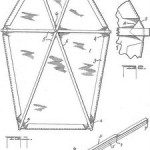 The Hi-Flier Manufacturing Company was founded by Harvey A. Sellers (1889-1976) in his Decatur, Illinois, basement. He got started by purchasing a patent to a bow kite from a Decatur inventor named Arthur W. Cash (US Patent # 1452956) and later that same year patented a barn-door kite in his own name. (US Patent #1453287, at right.) These two kite designs were the core of his business while production remained in Decatur. I’ve heard that Sellers (or the company) later obtained a patent on the Hi-Flier box kite, but I’ve been unable to find the patent. Sellers’ son, Harvey A. Sellers, Jr, was granted a patent on a “gliding kite” in 1965. This resembles but was not the “Glite” kite sold well into the 1970s by North Pacific Products (now defunct) of Bend, Oregon. (That was US Patent #3,276,730.) The bow kite patent date (1923) was printed on virtually every Hi-Flier bow kite ever made, and a lot of supposedly savvy antiques people believe that this indicates when the kite was manufactured. Not so—most surviving Hi-Flier kites date back to the late 50s at best. I’ve seen only a few older ones.
The Hi-Flier Manufacturing Company was founded by Harvey A. Sellers (1889-1976) in his Decatur, Illinois, basement. He got started by purchasing a patent to a bow kite from a Decatur inventor named Arthur W. Cash (US Patent # 1452956) and later that same year patented a barn-door kite in his own name. (US Patent #1453287, at right.) These two kite designs were the core of his business while production remained in Decatur. I’ve heard that Sellers (or the company) later obtained a patent on the Hi-Flier box kite, but I’ve been unable to find the patent. Sellers’ son, Harvey A. Sellers, Jr, was granted a patent on a “gliding kite” in 1965. This resembles but was not the “Glite” kite sold well into the 1970s by North Pacific Products (now defunct) of Bend, Oregon. (That was US Patent #3,276,730.) The bow kite patent date (1923) was printed on virtually every Hi-Flier bow kite ever made, and a lot of supposedly savvy antiques people believe that this indicates when the kite was manufactured. Not so—most surviving Hi-Flier kites date back to the late 50s at best. I’ve seen only a few older ones.
Hi-Flier did very well, and was selling twenty million kites a year at a time when there were only seven million kids of kite-flying age in the country. Sellers understood the nature and economics of paper kites when he said that “…a kite not caught in a tree is like an ice-cream cone not eaten.” By making them inexpensive, he knew his little “consumers” would just go back to the dime store and buy another when the trees took their inevitable due. (Quoted from this.)
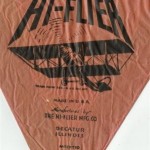 Anyway. Hi-Flier as a brand name is still alive, but the company in Decatur, IL is long gone. I’ve had a hard time determining who actually owns the trademark today. A company called Damon Industries bought Hi-Flier in the early 1970s and owned it for many years. Damon also once owned Estes Model Rockets of Penrose, Colorado, but sold Estes to a group of investors in the early 1990s. Estes still sells a high-altitude (1600′) model rocket called the Hi-Flier, though this is probably a holdover from the days when Damon owned the company. Another company called Galoob Toys (now owned by Hasbro) used to make kites under the Hi-Flier name. Someone is now selling Hi-Flier marbles and other small toys, though I don’t know who. I’m still actvely researching this issue, and will update this essay whenever I discover something significant. I intend at some point to fly down to Decatur from Chicago for a day or two and dig around in the public library there, which may turn up some interesting things.
Anyway. Hi-Flier as a brand name is still alive, but the company in Decatur, IL is long gone. I’ve had a hard time determining who actually owns the trademark today. A company called Damon Industries bought Hi-Flier in the early 1970s and owned it for many years. Damon also once owned Estes Model Rockets of Penrose, Colorado, but sold Estes to a group of investors in the early 1990s. Estes still sells a high-altitude (1600′) model rocket called the Hi-Flier, though this is probably a holdover from the days when Damon owned the company. Another company called Galoob Toys (now owned by Hasbro) used to make kites under the Hi-Flier name. Someone is now selling Hi-Flier marbles and other small toys, though I don’t know who. I’m still actvely researching this issue, and will update this essay whenever I discover something significant. I intend at some point to fly down to Decatur from Chicago for a day or two and dig around in the public library there, which may turn up some interesting things.
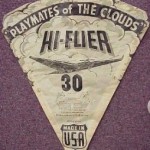 It’s unclear when Hi-Flier’s Decatur operation ceased (our best guess is 1988 or so) but the paper kite business in general is now long extinct. Even the ad/promo kites that used to be Hi-Flier’s bread and butter are now made of plastic somewhere else (generally China) and fly poorly if they fly at all. (There’s one exception: The RB Toy Development Company’s “Giant Kite,” which many of us saw as the “Green Giant kite” during periodic boxtop campaigns for frozen veggies as long ago as 1987. They flew beautifully, though they have not been made for quite a few years.)
It’s unclear when Hi-Flier’s Decatur operation ceased (our best guess is 1988 or so) but the paper kite business in general is now long extinct. Even the ad/promo kites that used to be Hi-Flier’s bread and butter are now made of plastic somewhere else (generally China) and fly poorly if they fly at all. (There’s one exception: The RB Toy Development Company’s “Giant Kite,” which many of us saw as the “Green Giant kite” during periodic boxtop campaigns for frozen veggies as long ago as 1987. They flew beautifully, though they have not been made for quite a few years.)
There were three different types of kites in the Hi-Flier canon during the time I flew them, which was roughly 1958 through 1970. Two are well-known, and the third I saw only once in that time period, in (I think) 1966. Here’s the summary:
- The classic two-stick diamond bow kite. These were made in three sizes and two materials. The two smaller sizes sold in paper for 10 cents, and a larger size in paper sold for 15 cents. The smallest size was also available in plastic, for a quarter.
- The paper box kite. These cantankerous, fragile, and short-lived beauties cost fifty cents at that time.
- The three-stick six-sided “barn door” flat paper kite. These are quite rare and I have very little experience with them.
Later on, Hi-Flier produced a number of interesting kites, all of them in plastic. By the early 1980s, plastic delta kites had become the rage, and paper bow kites gradually went into eclipse. Keep in mind that after the Decatur operation ceased and “Hi-Flier” was reduced to being a brand name licensed to other toy manufacturers, the name was applied to lots of other species of toys, including marbles and yoyos.
The Hi-Flier diamond kites came in three sizes, specified by the length of the long (vertical) stick:
- Small: The vertical stick was 29 1/4″ and the bow stick was 23 3/4″.
- Medium: The vertical stick was 36″ and the bow stick 29 1/4″. Note that the bow stick of this size was the same as the vertical stick in the small size.
- Large: The vertical stick was 42″ and the bow stick 36″. Again, the bow stick was the same size as the long stick in the next smaller size. This allowed Hi-Flier to make three different sizes of kites with only four sizes of stick.
The Small Kites (30″)
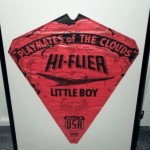 The small paper diamond kites were 10c when I was flying them. (They later went up to 15c, and before the end of the Hi-Flier era, 49c.) These were my favorites. Two coke bottles found in an empty lot could be returned at the C&T Certified at Canfield and Talcott (around the corner from Bud’s hardware store) and generate funds to buy one. The price went up after I got out of grade school, and in fact the American Beauty kite I have hanging on my wall carries the price 49c, meaning it must have been manufactured as late as the mid-1970s. The small kites were the best flyers of anything in the Hi-Flier product line.
The small paper diamond kites were 10c when I was flying them. (They later went up to 15c, and before the end of the Hi-Flier era, 49c.) These were my favorites. Two coke bottles found in an empty lot could be returned at the C&T Certified at Canfield and Talcott (around the corner from Bud’s hardware store) and generate funds to buy one. The price went up after I got out of grade school, and in fact the American Beauty kite I have hanging on my wall carries the price 49c, meaning it must have been manufactured as late as the mid-1970s. The small kites were the best flyers of anything in the Hi-Flier product line.
The bulk of the small kites that I flew were the “Playmates of the Clouds” design, which may well have been the commonest Hi-Flier art design of that period. The artwork had a futuristic flying wing aircraft in the center, below the logo “Hi-Flier.” Below the aircraft there was sometimes a number (generally 30, though I recall other numbers including 6 and 94), sometimes the words “Little Boy,” and sometimes nothing at all.
The Playmates of the Clouds kites came in a wonderful variety of colors, though the art design was almost entirely identical. Here are the color schemes that I have seen so far, either when I was flying them or more recently on the collector market. I’m guessing that there are more:
- Black on Red paper
- Black on White paper
- Black on Yellow paper
- Green on Light Yellow paper
- Green on White paper
- Dark Blue on Light Blue paper
- Dark Blue on Red paper
- Dark Blue on Light Yellow paper
- Light Blue on Light Yellow paper
- Magenta on White paper
- Red on White paper
- Orange on White Paper
- Orange on Light Yellow paper
The Strat-O-Flier and the Cosmic were two other designs that I’ve seen in the 30″ size, but many or most of the advertising promo kites were of this size as well. The Rainbow design was unusually good, though I never saw it “in the field.” The Rainbow design was also used in the barn door kites late in the barn door era.
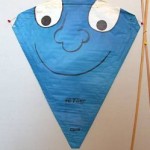 The 1977 Hi-Flier wholesale catalog still contains 30″ paper kites, and calls the category “Little Boy” even though the Playmates design had by then been retired. The “Silly Face” design (right) was printed in several colors and is common on eBay, and there is a pirate design shown in the catalog that I have not yet seen for sale. These are good designs, however, because they are simple and large, and you can tell what they are when the kites are a long way out.
The 1977 Hi-Flier wholesale catalog still contains 30″ paper kites, and calls the category “Little Boy” even though the Playmates design had by then been retired. The “Silly Face” design (right) was printed in several colors and is common on eBay, and there is a pirate design shown in the catalog that I have not yet seen for sale. These are good designs, however, because they are simple and large, and you can tell what they are when the kites are a long way out.
At the very end of the paper kite era, in the midlate 80s, Hi-Flier was doing some interesting art designs in the small kite size. One was a third expression of the American Beauty design, but with a WWI-era biplane in the foreground, and clouds intermingling with the stars. Another, clearly by the same artist, showed similar biplanes in a dogfight.
At about the same time, Hi-Flier released a series of five 30″ kites with simple and stylized art designs: An 18th Century sun motif, an astronaut, an eagle/firebird, an ice-cream soda, and a pure geometric design that reminds me of Celtic knotwork. This set was shipped in a cardboard box, bulk mail, with a return address of Box 9400, St Paul, MN 55177. The sender is not named. As with all bulk mail packages, the box is undated. I’m leaning toward the conclusion that these were ad promos or premiums of some sort, but I don’t know what firm was doing the promotion.
One of the most peculiar designs I’ve ever seen on a paper kite is a “psychedelic” expression (a orange spiral printed on yellow paper) of the chemical formula C12H22O11, which is…sugar! This may have been (and probably was) a promo of some kind, but I cannot imagine what or from whom.
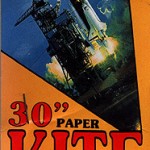 In 1987, Hi-Flier did something I had never before seen them do: Print a photograph on a paper kite. The kite shown at left, with the Space Shuttle lifting off, is the latest Hi-Flier paper kite that I’ve ever seen. (Note the copyright date on the packaging photo at left.)
In 1987, Hi-Flier did something I had never before seen them do: Print a photograph on a paper kite. The kite shown at left, with the Space Shuttle lifting off, is the latest Hi-Flier paper kite that I’ve ever seen. (Note the copyright date on the packaging photo at left.)
The small Hi-Flier diamond kites were absolutely wonderful flyers. In most Chicago winds that we dared fly in, they would fly tailless with very little trouble. In fact, once on a dare I tried flying one upside-down by pulling the bridle tie point way down the bridle string and flipping it over. Worked fine! In the sky it looked like an arrow (especially after I tied some tail to what would otherwise be the top point) and the other kids thought I was pretty clever to have pulled it off. Most of them never mastered kite flying, generally because they “knew” a kite required a tail, and persisted in tying entire bedsheets off the bottom stick and wondering why the damned things couldn’t get off the ground.
Like any other skill, kite-flying took practice, and a certain amount of study. (I took all three kite books out of out local public library repeatedly.) The small kites were wonderful “trainers” because they didn’t cost a lot of money, and if you wrecked one, you learned what you could from the experience, hunted up another couple of bottles, and bought another.
The Medium Kites (36″)
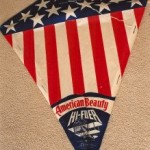 For a while the medium-sized diamond kites were also 10c at Bud’s Talcott Hardware, but they went up to 15c by the time I was in high school. The most common and in my opinion the most beautiful and effective design was the American Beauty. (See the photo in the header of this article.) Lots of kids were flying them on and just after the Fourth of July. They had a globe on a blue field at the top, with red and white strips below, and the legend “American Beauty” in red on white below the stripes. This always has been my favorite Hi-Flier graphics design, and I am proud to own a mint specimen. There was an older version of the American beauty (right, courtesy John J. Nauer) that I have seen only in photos but it is a bolder and I think a better design.
For a while the medium-sized diamond kites were also 10c at Bud’s Talcott Hardware, but they went up to 15c by the time I was in high school. The most common and in my opinion the most beautiful and effective design was the American Beauty. (See the photo in the header of this article.) Lots of kids were flying them on and just after the Fourth of July. They had a globe on a blue field at the top, with red and white strips below, and the legend “American Beauty” in red on white below the stripes. This always has been my favorite Hi-Flier graphics design, and I am proud to own a mint specimen. There was an older version of the American beauty (right, courtesy John J. Nauer) that I have seen only in photos but it is a bolder and I think a better design.
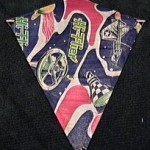 The “space warp” design (left) was available in both the 36″ size and the 44″ size when I flew them. It may have been available in the 30″ size, but I’ve not seen it. The same general design was also used on the later Hi-Flier box kites. It was a convenient design for the firm to re-use, because it was like a fabric print for kid’s bedspreads: The basic design repeated over and over without a single orientation or edges aligned with the structure of the kite. It was available in a number of color combinations. There were a series of handsome new designs on the 36″ kites in the early-mid 1970s, including an Indian chief and “Stinger McBee.”
The “space warp” design (left) was available in both the 36″ size and the 44″ size when I flew them. It may have been available in the 30″ size, but I’ve not seen it. The same general design was also used on the later Hi-Flier box kites. It was a convenient design for the firm to re-use, because it was like a fabric print for kid’s bedspreads: The basic design repeated over and over without a single orientation or edges aligned with the structure of the kite. It was available in a number of color combinations. There were a series of handsome new designs on the 36″ kites in the early-mid 1970s, including an Indian chief and “Stinger McBee.”
Another older design I have seen only occasionally on eBay had the Playmates’ “flying wing” aircraft but little else, and the legend “Big Ben” at the kite’s center.
I’ve seen a few promo kites in the 36″ size, though most of them (especially late in the paper kite era) were 30″ in size.
The Large Kites (42″)
I don’t remember these as well, because I only flew a couple. The “space warp” design shown above is the one I remember best, though there have been a couple of others on eBay. I have recently seen an older kite in red with the legend “Big Boy” that was the size of the large kites that I flew, but it must have been a little before my time. It looked something like the “Playmates of the Clouds” kites, with a large “Hi-Flier” logo above an identical Buck Rogers airplane, and the slightly silly legend “Tailless Dancing Kite” toward the bottom. (This last seems to have been an early Hi-Flier slogan, but I don’t remember seeing it during my own kite days.) I’ve seen bow kites dance, but when they do, it usually means you don’t have the bridle set up correctly!
The latest (1976) of the large kites that I’ve seen is the plastic “Big Bruno,” showing a circus strongman holding up dumbells that are…balloons!
One of my friends preferred the large kites (which at that time cost 15c and soon afterward 25c) and looked down his pointy nose at my (small by comparison) American Beauties. He was smart, and figured out (as most kids never did) that a bigger kite would fly in less wind. I didn’t like them because they cost another redeemed bottle to buy, and once in the air it was impossible to tell that they were any bigger than my Playmates of the Clouds. And at the rate I wrecked kites (and with plenty of competition for scavenged bottles) the extra nickel seemed an unwarranted waste.
The Plastic Bow Kites
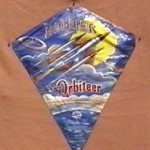 These cost a quarter when I flew them (later 29 cents and later on even more) and when I had quarters—which wasn’t often—I bought better things than kites. I remember flying a couple with my cousin Ron down in Blue Island. Ron was always spoiled and had the best toys, including the biggest Erector set I ever saw. The most common design for plastic bow kites was a Flash-Gordon style spacecraft with the legend “Orbiteer.” The one I flew is shown at right. The Orbiteer design was rearranged and freshened up a little in the late 1960s, when the slogan “Color-Glow” was added to all Hi-Flier’s plastic bow kites. There were two overall color schemes, blue (as shown here) and magneta. Plastic kites were made in all three of the standard kite sizes, though I have not seen an example of a 44″ plastic kite outside of the Hi-Flier catalog.
These cost a quarter when I flew them (later 29 cents and later on even more) and when I had quarters—which wasn’t often—I bought better things than kites. I remember flying a couple with my cousin Ron down in Blue Island. Ron was always spoiled and had the best toys, including the biggest Erector set I ever saw. The most common design for plastic bow kites was a Flash-Gordon style spacecraft with the legend “Orbiteer.” The one I flew is shown at right. The Orbiteer design was rearranged and freshened up a little in the late 1960s, when the slogan “Color-Glow” was added to all Hi-Flier’s plastic bow kites. There were two overall color schemes, blue (as shown here) and magneta. Plastic kites were made in all three of the standard kite sizes, though I have not seen an example of a 44″ plastic kite outside of the Hi-Flier catalog.
A less common design in plastic was the Pegasus kite, showing a flying horse against a striped background, in either red or blue. I have only recently (early 2006) seen an example of a Hi-Flier promo kite (for Dutch Boy Paints) in plastic. I have a photo of a “Hi-Flier Jet” kite in dark blue plastic from John Nauer, and have seen the same design on eBay in paper.
Featured Kitelife Sponsor:
The 1977 Hi-Flier catalog lists a 36″ plastic diamond kite called the “Goof-Proof Kite” with something called “Stik-Lok” assembly. I’ve never seen one of these and would love to know what the gimmick was. Ditto the “Daredevil” kite, which was an odd size (48″ X 34″) with a sail made of transparent Mylar and “automatic assembly.”
By 1977, virtually all Hi-Flier kites were made of plastic. This was not entirely because they were cheaper for the company to make, though I’m sure that was a factor. They were rugged. It took more than one dive into the bushes to shred one, but somehow I was never good at economics and didn’t do the math, even though I might have come out ahead had I gotten in the habit of hoarding a few more bottles and thinking, “Plastic!”
The Box Kites
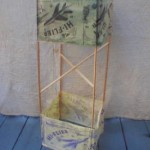 I lusted after these, and every so often (usually after Aunt Kathleen had given me a dollar for no good reason) I would buy one. In the period I was flying them they had a very simple art design: Just colored paper (usually green and white) with relatively small drawings of jet aircraft, helicopters and things. The physical design was diabolical: Each end was kept at very high tension by two cross-sticks that were slightly too long to fit inside the paper box portion, and had to bow a little. The paper was thus tight as a drum, and tore very easily. (This may be why I don’t see many assembled ones on the auction sites. Nobody wants to risk destroying a 35-year-old kite that might fetch fifty bucks!) The photo of a newer kite below (in the Hi Flier “space warp” design) comes from Peter Lamonica, and is of a later art design, with four color printing on white paper, rather than the earlier black or blue ink on colored paper. Peter hasn’t flown his yet and doesn’t intend to!
I lusted after these, and every so often (usually after Aunt Kathleen had given me a dollar for no good reason) I would buy one. In the period I was flying them they had a very simple art design: Just colored paper (usually green and white) with relatively small drawings of jet aircraft, helicopters and things. The physical design was diabolical: Each end was kept at very high tension by two cross-sticks that were slightly too long to fit inside the paper box portion, and had to bow a little. The paper was thus tight as a drum, and tore very easily. (This may be why I don’t see many assembled ones on the auction sites. Nobody wants to risk destroying a 35-year-old kite that might fetch fifty bucks!) The photo of a newer kite below (in the Hi Flier “space warp” design) comes from Peter Lamonica, and is of a later art design, with four color printing on white paper, rather than the earlier black or blue ink on colored paper. Peter hasn’t flown his yet and doesn’t intend to!
The reason is simple: They flew like demented birds of prey, swooping and zipping around at incredible speeds, pulling tremendously hard, almost always on the edge of being out of control. Flying one was the first adrenaline rush I can clearly recall. Each represented a lot of kid-capital, and having seen plenty of them die at other kids’ hands, there was a lot of anxiety in trying to get them to rise and sit still.
Sit still? Hah. No chance. Not even by me, who considered his twelve-year-old self a black-belt kitemaster. In the strange divided drafts that beset the too-small Edison schoolyard, they flew like crazed eagles, often for no more than a few seconds before diving full-speed straight down from seventy feet in the air and exploding into sticks and shreds in the muddy spring grass.
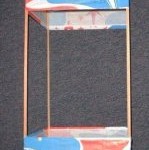 As got to be twelve and thirteen, I justified the expense of Hi-Flier box kites because after they crashed, I could scavenge the long sticks and build bow kites with the sticks. An unbroken stick was the vertical, and a broken stick (always at one of the two notches about 3″ from the ends) became the bow stick. I covered them with newspaper, which tore a lot, but was free and abundant in the basement. Eventually I could strip the paper from a kite and re-string and re-paper it inside of five minutes, although I was covered with mucilage by the time I was done. Not that I cared. (Does anybody even remember mucilage, and the smushy flesh-colored noses on the bottles that you used to spread the goop on the paper flaps around the edges of your kite?)
As got to be twelve and thirteen, I justified the expense of Hi-Flier box kites because after they crashed, I could scavenge the long sticks and build bow kites with the sticks. An unbroken stick was the vertical, and a broken stick (always at one of the two notches about 3″ from the ends) became the bow stick. I covered them with newspaper, which tore a lot, but was free and abundant in the basement. Eventually I could strip the paper from a kite and re-string and re-paper it inside of five minutes, although I was covered with mucilage by the time I was done. Not that I cared. (Does anybody even remember mucilage, and the smushy flesh-colored noses on the bottles that you used to spread the goop on the paper flaps around the edges of your kite?)
The box kites were sold from the early 1950s well past the time I was flying kites from Bud’s Hardware Store, and I don’t know when they went out of production. They must have been fairly expensive to make, and they had a bad rep among kids for their habit of self-destructing. They were gone from the Hi-Flier catalog in 1977 and possibly before. As I learn more, I’ll update the story here.
The Barn Door Kites
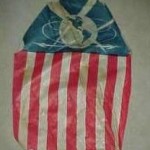 These are the rarest of all the early Hi-Flier kites, and I myself have never had the honor of flying one. In fact, I saw exactly one specimen in the field, in the hands of a boy near my parents’ summer home at Third Lake, IL, in ’65 or ’66. It was definitely made by Hi-Flier, and it had the word “Rainbow” on it, along with a colorful rainbow motif. The kite was quite small, and the poor kid had no luck getting it in the air. He told me he got it free when his dad bought him a pair of shoes in Grayslake. I have since seen the “Rainbow” design on a 2-stick 30″ paper kite offered on eBay. It was the same design on the barn-door kite I saw back in ’66. Hi-Flier made multiple uses of its designs, as shown by the “American Beauty” design on the barn-door kite at left, and the many uses of the Playmates flying wing aircraft and the “space warp” art design over the years. (The American Beauty design shown above is the sail alone, unrolled but not assembled on the sticks.)
These are the rarest of all the early Hi-Flier kites, and I myself have never had the honor of flying one. In fact, I saw exactly one specimen in the field, in the hands of a boy near my parents’ summer home at Third Lake, IL, in ’65 or ’66. It was definitely made by Hi-Flier, and it had the word “Rainbow” on it, along with a colorful rainbow motif. The kite was quite small, and the poor kid had no luck getting it in the air. He told me he got it free when his dad bought him a pair of shoes in Grayslake. I have since seen the “Rainbow” design on a 2-stick 30″ paper kite offered on eBay. It was the same design on the barn-door kite I saw back in ’66. Hi-Flier made multiple uses of its designs, as shown by the “American Beauty” design on the barn-door kite at left, and the many uses of the Playmates flying wing aircraft and the “space warp” art design over the years. (The American Beauty design shown above is the sail alone, unrolled but not assembled on the sticks.)
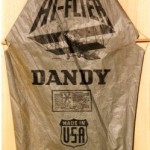 I have seen only a couple of examples offered on eBay. One looks vaguely like the “Playmates of the Clouds” kites, with the same futuristic aircraft, but has the word “Dandy” or “Little Ace” under the art. These predated me, I’m sure, and probably hail from the early 50’s or even the late 40’s. The kite at right is from John J. Nauer’s collection, and is a rare example of the original Hi-Flier biplane logo on a kite.
I have seen only a couple of examples offered on eBay. One looks vaguely like the “Playmates of the Clouds” kites, with the same futuristic aircraft, but has the word “Dandy” or “Little Ace” under the art. These predated me, I’m sure, and probably hail from the early 50’s or even the late 40’s. The kite at right is from John J. Nauer’s collection, and is a rare example of the original Hi-Flier biplane logo on a kite.
The barn door kites were flat kites. They had three sticks, not two: an “X” of two sticks 23½” long, with a single 16″ stick crossing them at the center through a metal staple. There was no bow, though barn-door kites with a bow in the horizontal stick are possible and should fly well.
I suspect that the barn-door kites weren’t popular with kids because they took a fair amount of careful rigging: three separate bridles that had to meet above the kite’s dead center. They also required a tail—and without sufficient tail, my guess is that they lasted maybe ninety seconds in clumsy 9-year-old hands. To see a close-up of the instructions printed on the barn door kites (it’s the block of text beneath the words “Little Ace”) click here.
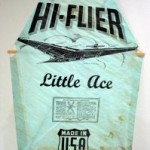 The barn door kites were quite small—even smaller than even the 30″ small bow kites—and having had some experience with small flat kites, I would guess that they took a fair amount of wind and were a significant challenge to get into the air. At left it is a photo I received from Robert Smallwood of Sydney, Australia, of a “Little Ace” barn door kite, fully assembled. Abundant thanks, Robert! I have a similar “Little Ace” barn door in my own collection, but the sail is in such terrible shape I don’t think I can even stretch it on its own sticks. That said, I hope at some point to re-create the Hi-Flier barn door design with new materials to see just how tough they are to fly.
The barn door kites were quite small—even smaller than even the 30″ small bow kites—and having had some experience with small flat kites, I would guess that they took a fair amount of wind and were a significant challenge to get into the air. At left it is a photo I received from Robert Smallwood of Sydney, Australia, of a “Little Ace” barn door kite, fully assembled. Abundant thanks, Robert! I have a similar “Little Ace” barn door in my own collection, but the sail is in such terrible shape I don’t think I can even stretch it on its own sticks. That said, I hope at some point to re-create the Hi-Flier barn door design with new materials to see just how tough they are to fly.
Advertising and Promo Kites
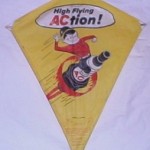 I didn’t know it at the time, but Hi-Flier must have done a tremendous business in promo kites, by which I mean the small-sized two-stick paper kites on which a business would have Hi-Flier print its company advertisement or other design and give them to kids as promotional items. The number of such kites to appear on eBay is completely incredible. Jif peanut butter, Sinclair and Texaco, Studebaker cars, Burger King, AC spark plugs, various local businesses and radio stations; it’s amazing. My wife received a Big Boy Fan Club kite at a Big Boy restaurant in 1973 (that Big Boy is now Kappy’s in Niles, Illinois) that literally sat stuck in my mother-in-law’s basement rafters for thirty years before we pulled it out and flew it in 1995. It survived the flight and now belongs to our nephew, who has flown it several times and miraculously still has it! Promo kites seem to have been made well into the late 1970s (or possibly the 1980s) and were probably a big profit center for the company. The promo kites exist in both 30″ and 36″ sizes, but most that I have seen are 30″. I have seen only one Hi-Flier promo kite in plastic, for Dutch Boy paints. (See photo below.)
I didn’t know it at the time, but Hi-Flier must have done a tremendous business in promo kites, by which I mean the small-sized two-stick paper kites on which a business would have Hi-Flier print its company advertisement or other design and give them to kids as promotional items. The number of such kites to appear on eBay is completely incredible. Jif peanut butter, Sinclair and Texaco, Studebaker cars, Burger King, AC spark plugs, various local businesses and radio stations; it’s amazing. My wife received a Big Boy Fan Club kite at a Big Boy restaurant in 1973 (that Big Boy is now Kappy’s in Niles, Illinois) that literally sat stuck in my mother-in-law’s basement rafters for thirty years before we pulled it out and flew it in 1995. It survived the flight and now belongs to our nephew, who has flown it several times and miraculously still has it! Promo kites seem to have been made well into the late 1970s (or possibly the 1980s) and were probably a big profit center for the company. The promo kites exist in both 30″ and 36″ sizes, but most that I have seen are 30″. I have seen only one Hi-Flier promo kite in plastic, for Dutch Boy paints. (See photo below.)
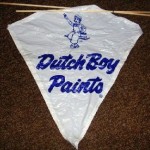 Every so often today I see a plastic diamond promo kite being handed out somewhere, but the kites are too small and too unstable to fly well. The only good plastic promo kite I’ve ever seen in recent years was a Green Giant promo that was a “boxtop” offer in the early 1990s. It was actually a five-point kite with plastic tubular sticks fitting into a molded plastic hub at the kite’s center. The hub had a 15″ dihedral angle, making it something like a bow kite without a bow. The string attached to a loop on the moded hub, and it flew beautifully in very light winds with neither bridle nor tail. I’ve written a short article about it, and the company that created it for the Leo Burnett advertising agency. Alas, we won’t be seeing any more of those, but they stand as some of the best mass-produced kites I’ve ever worked with.
Every so often today I see a plastic diamond promo kite being handed out somewhere, but the kites are too small and too unstable to fly well. The only good plastic promo kite I’ve ever seen in recent years was a Green Giant promo that was a “boxtop” offer in the early 1990s. It was actually a five-point kite with plastic tubular sticks fitting into a molded plastic hub at the kite’s center. The hub had a 15″ dihedral angle, making it something like a bow kite without a bow. The string attached to a loop on the moded hub, and it flew beautifully in very light winds with neither bridle nor tail. I’ve written a short article about it, and the company that created it for the Leo Burnett advertising agency. Alas, we won’t be seeing any more of those, but they stand as some of the best mass-produced kites I’ve ever worked with.
I sure wish some nostalgia-conscious company would troll around and find somebody who could make two-stick paper diamond kites with custom printed art. I’d pay $8 or $10 for such a kite, and if they could be made cheaply enough, they would be a sure seller in places like Restoration Hardware, which now sells repro 50s toys and other nostalgia items from the immediate Postwar era.
String and Winders
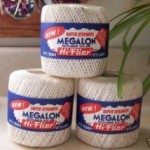 Hi-Flier sold a couple of other kite-related things as well. They sold branded kite line, but it looked like everybody else’s light cotton package twine and I suspect it was just a private label arrangement. They carried a late-era product called Megalon Kite Cord that was a much stronger line material, not cotton but some sort of synthetic fiber, and slightly dangerous in that you could cut into your hand with it if you tried to snap it by wrapping it around a finger and pulling hard. (With the cotton cord that was easy and most of us took it for granted as a field technique.) The upside to Megalon is that it would not break if the wind gusted a little too hard, as cotton twine was prone to do.
Hi-Flier sold a couple of other kite-related things as well. They sold branded kite line, but it looked like everybody else’s light cotton package twine and I suspect it was just a private label arrangement. They carried a late-era product called Megalon Kite Cord that was a much stronger line material, not cotton but some sort of synthetic fiber, and slightly dangerous in that you could cut into your hand with it if you tried to snap it by wrapping it around a finger and pulling hard. (With the cotton cord that was easy and most of us took it for granted as a field technique.) The upside to Megalon is that it would not break if the wind gusted a little too hard, as cotton twine was prone to do.
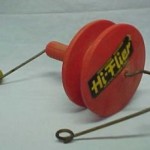 The best Hi-Flier product apart from kites, however, was their $1.29 Spinwinder kite reel. I never had one myself, but I watched a kid use one once down at Edison schoolyard, and it made winding string around a lumpy stick look pretty sick by comparison. The device was a red plastic spool with a handle, and through the handle was threaded a metal rod that bent into a crank at the bottom (with a ball-shaped wooden knob to grasp) and at the top into a loop that curved down level with the spool. You wound your line on the spool, and then threaded it just so over the bar and through a loop on the end to your kite. As you cranked the handle, the rod spun around and wound in your kite, placing your line neatly and tightly on the spool! The only downside was that letting line out in a hurry was problematic (and could be hard on the knuckles!) which is why I still use a “hose-reel” style reel when I fly. Nonetheless, the Spinwinder remains a very cool gadget. I recall sketching a clone made from a coffee can, but never got around to building it.
The best Hi-Flier product apart from kites, however, was their $1.29 Spinwinder kite reel. I never had one myself, but I watched a kid use one once down at Edison schoolyard, and it made winding string around a lumpy stick look pretty sick by comparison. The device was a red plastic spool with a handle, and through the handle was threaded a metal rod that bent into a crank at the bottom (with a ball-shaped wooden knob to grasp) and at the top into a loop that curved down level with the spool. You wound your line on the spool, and then threaded it just so over the bar and through a loop on the end to your kite. As you cranked the handle, the rod spun around and wound in your kite, placing your line neatly and tightly on the spool! The only downside was that letting line out in a hurry was problematic (and could be hard on the knuckles!) which is why I still use a “hose-reel” style reel when I fly. Nonetheless, the Spinwinder remains a very cool gadget. I recall sketching a clone made from a coffee can, but never got around to building it.
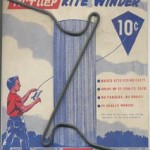 There was also a very simple bent-wire winder that was much cheaper, called the “Hi-Flier Kite Winder.” It sold, sans string, for ten cents. Supposedly it could hold a thousand feet of string, but I’m still a little dubious. To the ten-year-old I was in 1962, it seemed idiotic to buy what looked like a piece of coat hanger wire for 10c (that was the cost of a whole Playmates of the Clouds kite!) and so I tried imitating one by bending a coathanger into the same general shape. The string got seriously bollixed up with only a single 300-foot roll on it. Still, something that shape would certainly reel in the string faster than looping it around a skinny little stick.
There was also a very simple bent-wire winder that was much cheaper, called the “Hi-Flier Kite Winder.” It sold, sans string, for ten cents. Supposedly it could hold a thousand feet of string, but I’m still a little dubious. To the ten-year-old I was in 1962, it seemed idiotic to buy what looked like a piece of coat hanger wire for 10c (that was the cost of a whole Playmates of the Clouds kite!) and so I tried imitating one by bending a coathanger into the same general shape. The string got seriously bollixed up with only a single 300-foot roll on it. Still, something that shape would certainly reel in the string faster than looping it around a skinny little stick.
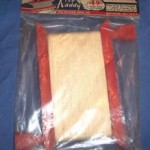 I have seen photos of one final type of kite winder, something called the “Hi-Flier Kite Kaddy,” which was a fairly conventional paddle-style winder made of either plastic or wood painted red. The Kite Kaddy appeared to come with string on it, and, judging by the price (49c) and the label design, looked like a fairly early product, probably late 1940s or early 1950s. I never encountered a genuine Hi-Flier one “in the field” but I have seen many home-made paddle-style kite reels in the intervening years.
I have seen photos of one final type of kite winder, something called the “Hi-Flier Kite Kaddy,” which was a fairly conventional paddle-style winder made of either plastic or wood painted red. The Kite Kaddy appeared to come with string on it, and, judging by the price (49c) and the label design, looked like a fairly early product, probably late 1940s or early 1950s. I never encountered a genuine Hi-Flier one “in the field” but I have seen many home-made paddle-style kite reels in the intervening years.
I watch the collector press and the auction sites for mention of other Hi-Flier products, and I’ll list them here as I discover them.
Non-Kite Products
Although I’ve never been a model airplane hobbyist, in researching Hi-Flier I discovered that the firm made and sold balsa flying model aircraft kits in two different eras.
The first era was in the late 1930s up until World War II, when production ceased. Hi-Flier hoped to re-enter the flying model aircraft market, and in 1975 bought Tern Aero, a kit design firm owned by veteran model designer Vito Garofalo. They repackaged Tern Aero’s kits and hoped to bring back the original pre-war Hi-Flier kits as well, but the models did not sell well and the line was shuttered just a few years later, in 1980.
Interestingly, model rocket manufacturer Estes Industries was for many years owned by Damon, which acquired Hi-Flier in (I think) 1981. Damon moved the Hi-Flier operation from Decatur to Penrose, Colorado (where Estes was based) in 1981. The history of Estes is complex, but it looks like Damon sold them in 1990 to an investor group that also owned Centuri, another model rocket manufacturer. There is a rocket in the Estes lineup (though I don’t think it’s still being manufactured) named the Hi-Flier, and the logo printed on the side has a strong resemblance to the Damon-era Hi-Flier logo.
In recent years the Hi-Flier brand has been licensed around a lot. On eBay I’ve seen neon jump ropes and plastic bowling games, as well as bags of marbles. There is some evidence that importer/packager Galoob Toys licensed the Hi-Flier name for awhile but have no details. Galoob was bought by Hasbro in 1998 and at that point the trail goes cold.
Hi-Flier’s Competitors
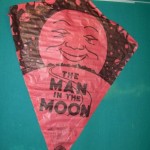 Other companies made paper kites down through the years, but none of them ever came close to Hi-Flier in market penetration. The one best remembered these days is TopFlite, which was a brand of paper kite fielded by Crunden-Martin Mfg. Co. of St. Louis. Kites were a sideline for Crunden-Martin and the company did many other things. (Their headquarters building in St. Louis is now on the National Register of Historic Places. Photos here.) Crunden-Martin filed for Chapter 11 bankruptcy in 1990 and apparently went out of business (rather than reorganizing and trying again) and it’s far from clear when they actually stopped making TopFlite Kites. I would very much like to write a whole article on Crunden-Martin and the TopFlite kites, but detailed information has proven scarce. If you know anything about them, please drop me a line!
Other companies made paper kites down through the years, but none of them ever came close to Hi-Flier in market penetration. The one best remembered these days is TopFlite, which was a brand of paper kite fielded by Crunden-Martin Mfg. Co. of St. Louis. Kites were a sideline for Crunden-Martin and the company did many other things. (Their headquarters building in St. Louis is now on the National Register of Historic Places. Photos here.) Crunden-Martin filed for Chapter 11 bankruptcy in 1990 and apparently went out of business (rather than reorganizing and trying again) and it’s far from clear when they actually stopped making TopFlite Kites. I would very much like to write a whole article on Crunden-Martin and the TopFlite kites, but detailed information has proven scarce. If you know anything about them, please drop me a line!
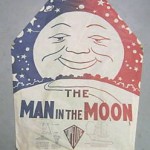 The best-known TopFlite kite design is probably the Man in the Moon, followed closely by the Jolly Roger. The Man in the Moon design was sold in both a diamond version and a barn-door version. Many people remember these as Hi-Fliers, because they are the same size and proportions, and printed on the same kind of paper. Interestingly, TopFlite used plastic sticks on some of their later paper kites. (See the photo above.) A nice diamond Man in the Moon specimen recently sold on eBay for over $300—and the barn door version shown here for just under $300! The Jolly Roger kites sell for just about as much if they’re in unusually good condition. It’s an excellent design, as you can still see the artwork when the kite is way out there.
The best-known TopFlite kite design is probably the Man in the Moon, followed closely by the Jolly Roger. The Man in the Moon design was sold in both a diamond version and a barn-door version. Many people remember these as Hi-Fliers, because they are the same size and proportions, and printed on the same kind of paper. Interestingly, TopFlite used plastic sticks on some of their later paper kites. (See the photo above.) A nice diamond Man in the Moon specimen recently sold on eBay for over $300—and the barn door version shown here for just under $300! The Jolly Roger kites sell for just about as much if they’re in unusually good condition. It’s an excellent design, as you can still see the artwork when the kite is way out there.
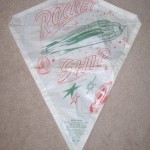 Alox Manufacturing was founded in St. Louis in 1919 by inventor John Frier (1895-1974) and got its start making shoelaces, and later on manufactured theatrical canes (the ones you might see in a chorus line or in the 1920s by people “putting on the Ritz”) and a broad line of toys that included yo-yos, whistles, jacks, jump-ropes, Chinese checkers sets, and especially marbles. Their marble plant operated 24/7 for years—using both new glass and glass recycled from colored bottles—and their marbles are much in demand by collectors. They had some defense contract work as well, and Alox made balloon-borne radar corner-reflector targets for the Army Signal Corps in the late 1940s that may have been the trigger for some of the first UFO sightings.
Alox Manufacturing was founded in St. Louis in 1919 by inventor John Frier (1895-1974) and got its start making shoelaces, and later on manufactured theatrical canes (the ones you might see in a chorus line or in the 1920s by people “putting on the Ritz”) and a broad line of toys that included yo-yos, whistles, jacks, jump-ropes, Chinese checkers sets, and especially marbles. Their marble plant operated 24/7 for years—using both new glass and glass recycled from colored bottles—and their marbles are much in demand by collectors. They had some defense contract work as well, and Alox made balloon-borne radar corner-reflector targets for the Army Signal Corps in the late 1940s that may have been the trigger for some of the first UFO sightings.
The Alox kite line goes all the way back to the company’s founding in 1919, and continued until the company closed its doors in 1989. They made box kites, diamond kites, and barn door kites in both paper and plastic versions. Alox aquired the assets of Wilder Manufacturing in St. Louis in 1937. Wilder manufactured paper kites, in the “Eagle Flyer” design, in both diamond and barn-door versions. I have recently made the aquaintance of Nancy Frier, John Frier’s granddaughter, who is the source of most of the information I have on both Alox and Wilder. I have a separate article on Alox kites that includes photos of some of the kites and one of the machines on which kites were being made. Nancy actually worked the presses and folding machines in the 1970s and 1980s, and still has the copper letterpress plates from which the Alox kites were printed. She is trying to find a firm that can print new kites from the original plates—so Alox kites may in fact fly again!
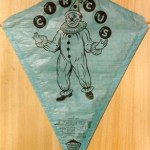 Beyond TopFlite and Alox, there just weren’t a lot of companies making paper kites in the Hi-Flier style. One was Cloudbuster Kites, which I have seen on the collector market but never in stores back in my youth. The kites look pre-1960 somehow, but I have no good information on when Cloudbuster was in operation. I think Cloudbuster may eventually have been acquired by TopFlite or vise versa, because I have seen the same design (the Circus Clown, at right, from the John J. Nauer collection) with both firms’ logos, but have had no confirmation. I do not know where the company was located. If you have any information on Cloudbuster kites, especially what firm made them and when, please pass it along.
Beyond TopFlite and Alox, there just weren’t a lot of companies making paper kites in the Hi-Flier style. One was Cloudbuster Kites, which I have seen on the collector market but never in stores back in my youth. The kites look pre-1960 somehow, but I have no good information on when Cloudbuster was in operation. I think Cloudbuster may eventually have been acquired by TopFlite or vise versa, because I have seen the same design (the Circus Clown, at right, from the John J. Nauer collection) with both firms’ logos, but have had no confirmation. I do not know where the company was located. If you have any information on Cloudbuster kites, especially what firm made them and when, please pass it along.
H & W Kite #202, date unknown
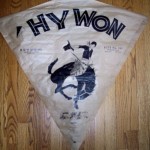 Way back in 2002, a reporter doing research on Hi-Flier for a Decatur newspaper article turned up a story about someone who had quit Hi-Flier and started a competing kite company in the 1930s. I heard nothing about that until very recently, when an odd kite turned up on eBay. The kite was made by the H & W Kite Company of Decatur, Illinois. Information printed on the kite led me to US patent #1904728, issued in 1933 to John Hahn of H & W Kite Company in Decatur. The patent looks like an incremental improvement of the paper folding and the metal clamp holding the two sticks together, but it mostly looks like the same design sold by HI-Flier, Alox, and Wilder in that era. Doubtless the “H” in “H & W” was Mr. Hahn. The patent says that H & W was an Illinois corporation, and there may be public records that provide more detail on the company and when it was operating. I’ll investigate, but as with any other player in the paper kite game, I’d like to hear more about this if you have any knowledge.
Way back in 2002, a reporter doing research on Hi-Flier for a Decatur newspaper article turned up a story about someone who had quit Hi-Flier and started a competing kite company in the 1930s. I heard nothing about that until very recently, when an odd kite turned up on eBay. The kite was made by the H & W Kite Company of Decatur, Illinois. Information printed on the kite led me to US patent #1904728, issued in 1933 to John Hahn of H & W Kite Company in Decatur. The patent looks like an incremental improvement of the paper folding and the metal clamp holding the two sticks together, but it mostly looks like the same design sold by HI-Flier, Alox, and Wilder in that era. Doubtless the “H” in “H & W” was Mr. Hahn. The patent says that H & W was an Illinois corporation, and there may be public records that provide more detail on the company and when it was operating. I’ll investigate, but as with any other player in the paper kite game, I’d like to hear more about this if you have any knowledge.
Know Anything More?
That’s a summary of pretty much everything I know right now about Hi-Flier. I’m always looking for more information, especially on when kite manufacturing ceased at the Decatur plant, and whether or not kites were ever made in Penrose, Colorado. Scans of old Hi-Flier wholesale catalogs and sales literature would be very helpful. Do get in touch through my website!


